Disclosure: Some links on this page are monetized by the Skimlinks, Amazon, Rakuten Advertising, and eBay, affiliate programs, and Liliputing may earn a commission if you make a purchase after clicking on those links. All prices are subject to change, and this article only reflects the prices available at time of publication.
The Amazon Fire Max 11 is a tablet with an 11 inch, 2000 x 1200 pixel IPS LCD display, 4GB of RAM, at least 64GB of storage, and the fastest processor available in a current-gen Amazon Fire tablet. It also has an aluminum body, support for optional keyboard and pen accessories, and… the highest price tag of any Fire tablet, with list prices starting at $230 (unless you snagged one cheaper on Prime Day).
That makes the Fire Max 11 less of an impulse purchase than some of Amazon’s cheaper tablets… especially since, like all of the company’s tablets, the Fire Max 11 ships with the Amazon’s fork of Android called Fire OS. That means instead of the Google Play Store you get the Amazon Appstore, with a much more limited selection of apps. But as of mid-July, 2023 it’s very easy to install the Google Play Store on the Fire Max 11, making it feel a bit more like a standard Android tablet. Here’s how to do it.

Before we get started, I should note a few things. First, there’s currently no known way to completely replace Fire OS with another version of Android. That means you’re still going to have Amazon’s apps, services, user interface, and home screen launcher even after installing the Play Store.
But if you do install the Play Store, you’ll get easy access to millions of apps that aren’t available in the Amazon Appstore including Google apps like Chrome, Gmail, and YouTube. That includes Android apps you may have already paid for in the Play Store, saving you the trouble of buying them again from Amazon.
There’s a chance that not every app will work correctly though, especially if you’re trying to use apps that require on Google services which may not be available.
And there’s also a chance that Amazon could roll out a software update that will make installing the Google Play Store more difficult or even impossible… although hackers have a pretty good track record of finding workarounds. It’s often recommended that after installing Google Play on a Fire Tablet, you take steps to disable over-the-air software updates to prevent Amazon from removing access… although that’s a moving target, since Amazon often rolls out updates that make it more challenging to block future updates.

If you truly want a tablet that works well with the Google Play Store, your best bet is still to buy a model that ships with its pre-installed. Samsung, Lenovo, and others offer a number of affordable options. But Amazon’s Fire tablets are hard to beat when it comes to the price/performance ratio: the Fire Max 11 costs less than a Samsung Galaxy Tab S6 Lite and has the same screen resolution, memory, and storage options. But Amazon’s tablet but has a faster processor, a higher-res front camera, and support for WiFi 6 and Bluetooth 5.3 (compared with WiFi 5 and BT 5.0 for Samsung’s tablet).
Anyway, the steps listed in this article have been tested on a Fire Max 11 tablet running Fire OS 8.3.1, and should work with Fire OS 8.3.2 as well We’re going to do this by downloading and installing four Android applications.
Step 1: Enable installation of apps from unknown sources
Before we can install apps that are not downloaded from the Amazon Appstore, we need to enable installation of apps from unknown sources.
You can do this by following these steps:
- Tap the Settings icon on the tablet’s home screen (or the Settings icon from the Quick Launch menu that appears when you pull down from the top of the screen with two fingers)
- Tap the Security & Privacy option on the Settings main screen.
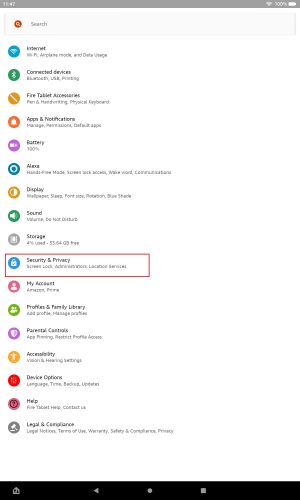
- On the Security & Privacy Page, tap the option that says Apps from Unknown Sources.
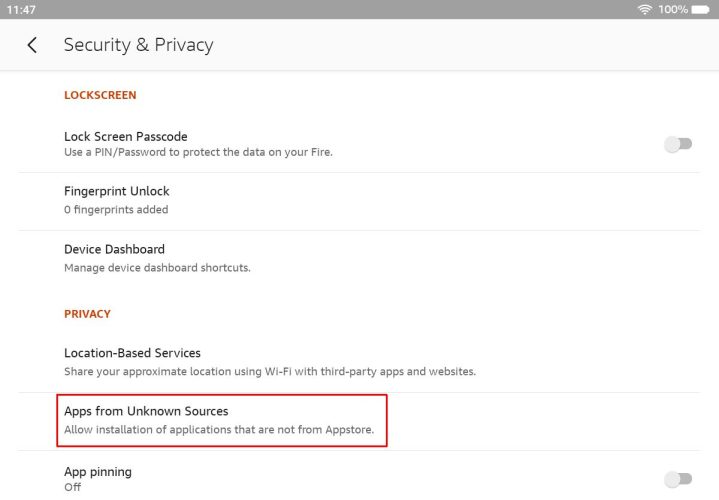
- On the next page you’ll see a list of apps that can install apps, like web browsers. If you haven’t installed any other apps yet, you’ll probably only see the Silk Browser listed on this page. Go ahead and tap it.

- On the following page, slide the toggle that says Allow from this source.
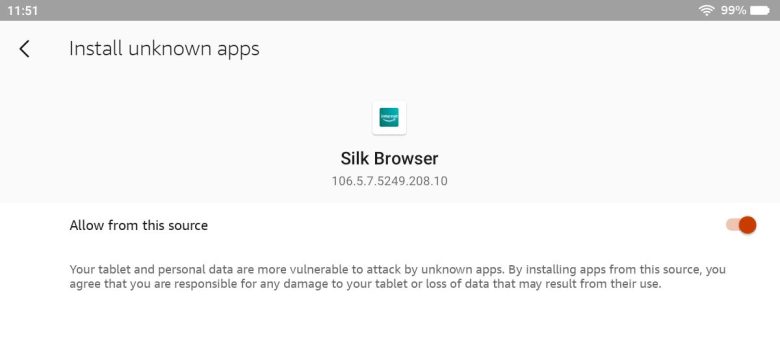
Now you can download Android APK installer files using the Silk web browser and install them on your tablet.
Step 2: Download these 4 apps
Now we need to download four Google apps that will install the Play Store and necessary services. Make sure not to install them yet. Just go ahead and download the following files.
Note that I’m including links to APKMirror. It’s a website that allows you to download Android apps if you have a device that may not have access to the Play Store, as well as older (or different) versions of apps. If you just need one or two apps that aren’t in the Amazon Appstore, you may want to just see if you can get them from APKMirror rather than installing the Play Store.
I should also note that APKMirros is also a pretty ad-heavy website. The download links are typically pretty safe, just make sure not to click on a deceptive ad by accident.
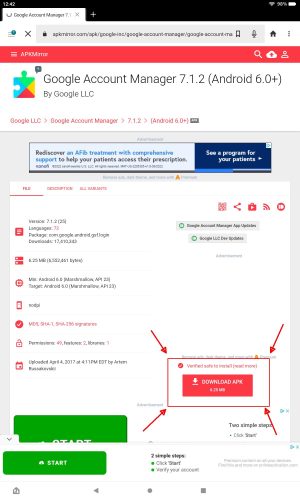
Okay, here are the APK files you should download for an Amazon Fire Max 11 (or any other recent Amazon tablet running Fire OS 8, including the Fire HD 8 (2022) or Fire 7 (2022).
- Google Account Manager 7.1.2
- Google Services Framework 10
- Google Play Services (arm64, nodpi, Android 11+) – get the latest non-beta version
- Google Play Store – get the latest non-beta version
Step 3: Install the apps
Next, you need to install each of those apps in the correct order.
- Open the Files app
- Navigate to the Downloads folder (the Fire tablet will open the Documents folder by default, but you can tap the three lines in the upper left corner to open a menu and then select the option that says Downloads)
- Switch from the grid view to list view so you can see the full file names.
- In order to install an app, you just tap on the app you want to install and then tap the Continue button.
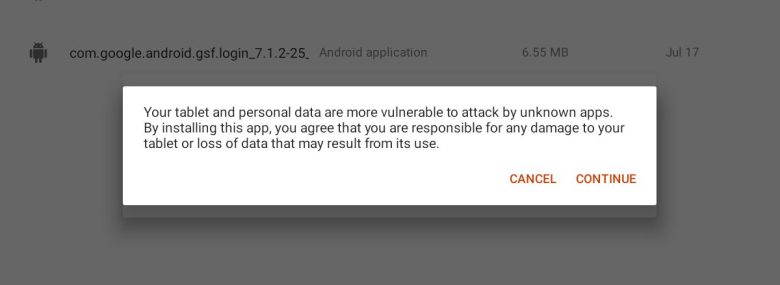
- Do that for all four apps, in this order:
- com.google.gsf.login
- com.google.android.gsf
- com.google.android.gms
- com.android.vending
Step 4: Reboot your tablet
Next, press and hold the power button on your tablet and tap the Restart option.

Step 5: Login to the Play Store
Once your tablet restarts, you should see the Play Store on your home screen. Tap it and you should be able to login with your Google credentials and begin downloading Android apps from the Play Store.
Step 6: Some other things you may want to do
Okay, so now you’ve got the Play Store installed on your Fire Max 11. But, like I said, not all Android apps will run perfectly out of the box. There are some workarounds that may help though.
For example, many users have noticed that the Chrome web browser doesn’t work properly unless you enable all permissions for it. Here’s how to do that:
- After installing Chrome, you should see the Chrome icon on your home screen. Long-press on it and then tap the option that says App info
- On the following screen, tap the option that says Permissions.
- On the next screen you should see that Camera, Contacts, Files, and Media, Location, and Microphone permissions are all denied.
- One at a time, tap on these and choose the options that say “allow,” or “allow only when using the app.”
After doing that, hopefully Chrome should work properly.
If you have a Windows or Linux PC, you may also want to install Fire Toolbox, which is an unofficial utility for Fire tablet hacking.
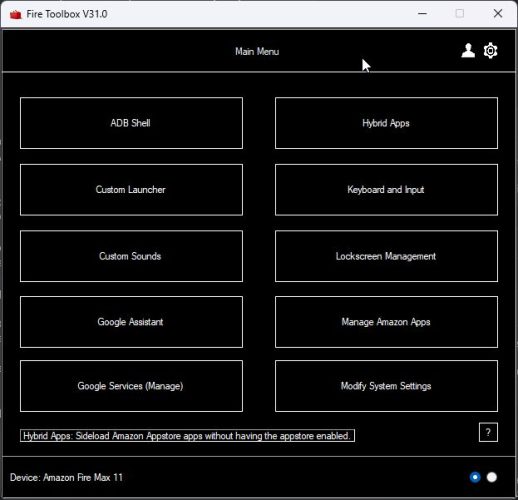
Among other things, it can simplify the process of installing the Play Store, attempt to block over-the-air updates, and attempt to disable some Amazon apps and services to make Fire OS work more like other versions of Android.
Users and the developer behind Fire Toolbox have noted that Fire OS 8.1.3.9, (which is the most recent build of Amazon’s tablet operating system as of mid-July, 2023), locks down some apps and services, making it more difficult to perform some modifications. For example, if your tablet is already running Fire OS 8.1.3.9 you may not be able to block OTA updates unless another workaround is found. And disabling some Amazon apps appears to be temporary… they get reenabled automatically after a certain period of time.
While developers look for workarounds, it’s good to know that at least it’s still possible to install the Play Store, which makes it much easier to install many apps and games that aren’t found in the Amazon Appstore.

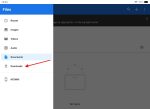

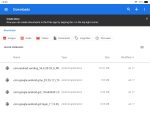
This might help. The first three worked but I got the parsing message on the last. It suddenly came to me to work my way down the list of apks. Bingo! The fourth one worked. Now a happy chappy with a fire 11 that has the Google play store on it
This document instructs the user to “get” and install “the latest non-beta version” of the Google Play Store.
This information needs revision for the Android version. The download for version 12+, which contains the substring “19-31,” failed to parse once downloaded. The download for version 10+, which contains “19-29,” works.
Hi I tried to install how you explained it out and it’s saying there was a problem parsing the package, what does this mean??
Download the version with the file name containing “19-29” for Android 10+.
Hey Brad – Thanks for bumping your old post about removing the recommendation line from the home screen! I agree it gets rid of one annoyance.
I just installed google apps/services on my 11 Max yesterday evening. Mine came with Fire OS 8.1.3.5 and I was able to retain that by skipping the WiFi setup and using Fire Toolbox v31.0 to disable OTA updates right away. I initially did the Amazon app debloat but that resulted in all Amazon functions not working. I did a hard reset and just installed the google apps and removed OTA updates and a few Amazon apps from the advanced menu. Everything seems to be working though I think the video driver could use a bit of work. YouTube playback isn’t always as smooth as it should be. FireOS 8.1.3.9 blocked some ADB functions so I’ll be staying on 8.1.3.5 until those issues are resolved by the Fire Toolbox developer. Overall it’s a nice tablet for the Prime Day price and it’s way faster and more reponsive than the my older Fire 10 Pro. It definitely needs the keyboard case because the metal housing (while nice looking) seems much more fragile than previous Fire tablets.
I picked one up on Prime Day for less than $100 after credits for trading in my HD 10 (2019), so I skipped the keyboard. But now that I’ve got the tablet in hand, I’m tempted to buy the keyboard next time it goes on sale for less than the $89 list price, because this does seem like a tablet that I might actually want to use with a keyboard.
That said, I mostly use these tablets for reading the news, eBooks, and digital comics and occasionally watching videos. So the cheap padded case I picked up years ago for $10 or $15 is probably fine for the occasional times I’ll take my tablet out of the house.
I did first run these steps on Fire OX 8.1.3.5 just to make sure I could. But once everything worked, I went ahead and updated to Fire OS 8.1.3.9 to verify that the same steps STILL work on the latest version of Amazon’s software since I imagine that will be what Fire Max 11 tablets ship with in the future and I wanted this article to be somewhat future-proof.
But I know that means I may need to wait for new workarounds in order to use some Fire Toolbox features.
Thanks for the info. It’s definitely a good idea to future proof the articles as much as possible. I used your previous article when I bought my Fire HD 10 Pro several years ago. Also, you’re probably right that the Max 11 will start shipping with OS 8.1.3.9 or newer soon. I was just happy that I got a previous OS version out of the box so I didn’t have to worry about some of the workarounds. I have actually been using the standard Fire OS launcher since I got mine, just in case the Nova Launcher workaround for 8.1.3.9 continues to have issues on that and later OS versions. I actually don’t miss the Nova launcher as much as I thought I would. I watched a bunch of videos last night and didn’t have any glitchiness so now I’m wondering if it wasn’t as much a driver issue as some background tasks running because the tablet had just been setup. In either case, I’m still very happy with the tablet a couple days in, and can’t wait to get my keyboard case installed tomorrow. I ordered the productivity bundle but shipping was delayed a couple days on the keyboard case for some reason. Maybe a bunch of people buying it on sale? I did wait until Prime Day was almost over before ordering.
Yeah, I also ordered mine with only a few hours to spare!
I spent way too much time trying to decide whether to buy this or the Samsung Galaxy Tab S6 Lite, but when I realized the Amazon tablet has a faster processor, cost $115 less with the trade-in of my Fire HD 10, and was something I could write about on Liliputing, it became a no-brainer 🙂
I also don’t really mind the stock Amazon launcher. It’s a lot less annoying these days than it used to be, and you can disable the recommendations at the top of the home screen to make the experience cleaner: https://liliputing.com/amazon-fire-tablets-how-to-disable-the-continue-discover-row-on-the-home-screen/
Thanks for the link, I hadn’t tried disable that row yet.